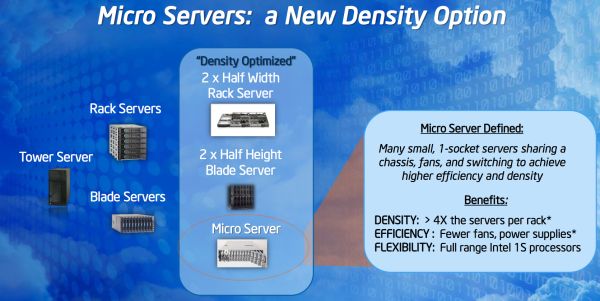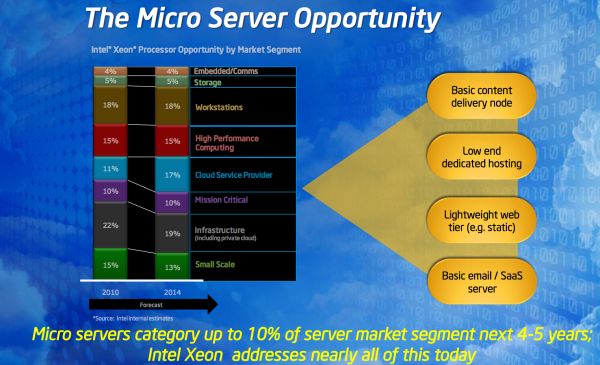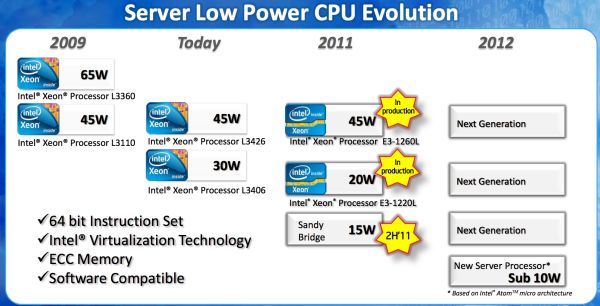Intel Plans on Bringing Atom to Servers in 2012, 20W SNB Xeons in 2011
by Anand Lal Shimpi on March 15, 2011 2:35 PM EST- Posted in
- IT Computing
- CPUs
- Intel
- Atom
- Xeon
The transition to smaller form factors hasn't been exclusively a client trend over the past several years, we've seen a similar move in servers. The motiviation is very different however. In the client space it's about portability, in the datacenter it's about density. While faster multi-core CPUs have allowed the two-socket 1U server to really take off, they have also paved the way for a new category of density optimized servers: the micro server.
The argument for micro servers is similar to that for ultra low power clients. Only a certain portion of workloads really require high-end multi-socket servers, the rest spend much of their time idle and thus are better addressed by lower power, higher density servers. Johan typically argues that rather than tackling the problem with micro servers it's a better idea to simply increase your consolidation ratio into fewer, larger servers. There are obviously proponents on both sides of the fence but Intel estimates that the total market for micro servers will reach about 10% of its total shipments over the next 4 - 5 years. It's a small enough market for Intel not to be super concerned about but large enough that it needs to be properly addressed.
Today Intel believes that it addresses this market relatively well with the existing Xeon lineup. Below is a table of Sandy Bridge Xeons including a 45W and 20W part, these two being directed primarily at the micro server market:
| Intel SNB Xeon Lineup | ||||||||
| Intel Xeon Processor Number | Cores / Threads | Clock Speed | Single Core Max Turbo | L3 Cache | Memory Support (Channels / DIMMs / Max Capacity) | Power (TDP) | ||
| E3-1280 | 4 / 8 | 3.50GHz | 3.90GHz | 8MB | 2 / 4 / 32GB | 95W | ||
| E3-1270 | 4 / 8 | 3.40GHz | 3.80GHz | 8MB | 2 / 4 / 32GB | 80W | ||
| E3-1260L | 4 / 8 | 2.40GHz | 3.30GHz | 8MB | 2 / 4 / 32GB | 45W | ||
| E3-1240 | 4 / 8 | 3.30GHz | 3.70GHz | 8MB | 2 / 4 / 32GB | 80W | ||
| E3-1230 | 4 / 8 | 3.20GHz | 3.60GHz | 8MB | 2 / 4 / 32GB | 80W | ||
| E3-1220L | 2 / 4 | 2.20GHz | 3.40GHz | 3MB | 2 / 4 / 32GB | 20W | ||
| E3-1220 | 4 / 4 | 3.10GHz | 3.40GHz | 8MB | 2 / 4 / 32GB | 80W | ||
Drop clock speed (and voltage) low enough and you can hit the lower TDPs necessary to fit into a micro server. Thermal constraints are present since you're often cramming a dozen of these servers into a very small area.
Long term there is a bigger strategy issue that has to be addressed. ARM has been talking about moving up the pyramid and eventually tackling the low end/low power server market with its architectures. While Xeon can scale down, it can't scale down to the single digit TDPs without serious performance consequences. Remember the old rule of thumb: a single microprocessor architecture can only address an order of magnitude of TDPs. Sandy Bridge can handle the 15 - 150W space, but get too much below 15W and it becomes a suboptimal choice for power/performance.
The solution? Introduce a server CPU based on Intel's Atom architecture. And this is the bigger part of the announcement today. Starting in 2012 Intel will have an Atom based low power server CPU with sub-10W TDPs designed for this market. Make no mistake, this move is designed to combat what ARM is planning. And unlike the ultra mobile space, Intel has an ISA advantage in the enterprise market. It'll be tougher for ARM to move up than it will be for Intel to move down.
Intel's slide above seems to imply that we'll have ECC support with this server version of Atom in 2012, which is something current Atom based servers lack.
The only real question that remains is what Atom architecture will be used? We'll see an updated 32nm Atom by the end of 2011 but that's still fundamentally using the same Bonnell core that was introduced back in 2008. Intel originally committed to keeping with its in-order architecture for 5 years back in 2008, that would mean that 2012 is ripe for the introduction of an out-of-order Atom. Whether or not that updated core will make it in time for use in Atom servers is still up for debate.













53 Comments
View All Comments
piroroadkill - Wednesday, March 16, 2011 - link
It's more suitable than Atom, by any measure.noeldillabough - Tuesday, March 15, 2011 - link
*If* and when the new version of Windows Home Server is finished and *if* its cool I'd be looking at one of these low power processors for its heart. What board(s) go best with low power Xeons?casket - Tuesday, March 15, 2011 - link
Arm is coming to windows... not surprised to see this."Microsoft announced on 5 January 2011 that the next major version of the Windows NT family will include support for ARM processors. Microsoft demonstrated a preliminary version of Windows (version 6.2.7867) running on an ARM-based computer at the 2011 Consumer Electronics Show.[88]"
Taft12 - Tuesday, March 15, 2011 - link
Why would it need to be one of these Xeons and not the 35W TDP Core i5?greenguy - Thursday, March 17, 2011 - link
ECC Ram.JGabriel - Monday, March 21, 2011 - link
Okay, but why do you need error-correcting RAM in a home server? Assuming the primary applications are serving files and multimedia, ECC seems unnecessarily robust for your purposes -- especially since buffered, registered, RAM costs twice as much.
anactoraaron - Tuesday, March 15, 2011 - link
Why not download the beta before making your server box?As far as I can see it's just like V1 but without the Drive Extender. The interface isn't that different, and it functions similarly to V1 WHS.
MrSpadge - Tuesday, March 15, 2011 - link
2 Sandy Bridge cores with a 20 W TDP running:Load on 2 cores: 2.2 GHz
Load on 1 core: 3.4 GHz
... that's how I want my dual core and what Bobcat should have been!
At least proportionally. 2 much slower and simpler cores at a maximum of 1.6 GHz at 18 W seems outright stupid in comparison. Sure, it's got a GPU included in this power envelope.. but this thing shouldn't consume power when it's not doing anything (as does the SNB-GPU), otherwise it's a really bad choice for the task at hand.
asmoma - Tuesday, March 15, 2011 - link
Turbo is coming to brazos. Google: AMD E-450mino - Tuesday, March 15, 2011 - link
Those SB chips also cost about the same a Brazos SYSTEM does. :)